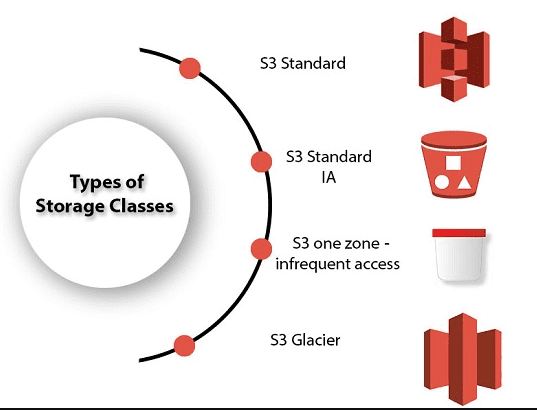Amazon S3 Intelligent-Tiering: Simple Data Management and Cost Savings
What is S3 Intelligent-Tiering?
Amazon S3 Intelligent-Tiering is a storage class provided by AWS (Amazon Web Services) that helps users manage their data more efficiently in the cloud. It is designed to automatically optimize storage costs and ensure easy access to data based on its usage patterns.
Amazon S3 offers several storage tiers to meet different data access and cost requirements:
Standard Storage:
Offers high-performance access to frequently accessed data, suitable for active workloads.
Intelligent-Tiering:
Automatically moves objects between Frequent Access and Infrequent Access tiers based on access patterns, optimizing storage costs while ensuring data availability
Standard-IA (Infrequent Access):
Lower-cost storage class for infrequently accessed data with a minimum storage duration, ideal for backups and long-term storage.
One Zone-IA:
Similar to Standard-IA but stores data in a single Availability Zone, offering lower costs but with less resilience compared to other storage classes
Glacier:
Very low-cost archival storage with data retrieval times ranging from minutes to hours, suitable for long-term data retention and compliance requirements.
Glacier Deep Archive:
The most cost-effective archival storage with longer retrieval times, ideal for data that rarely needs to be accessed and has long-term retention needs.
How does s3 storage class work?
With Intelligent-Tiering, AWS monitors the access patterns of your data in the S3 bucket. It then automatically moves objects between two access tiers – Frequent Access and Infrequent Access – depending on how often they are accessed.
Benefits of Frequent and Infrequent Access Tiers
Frequent Access Tier: Objects that are frequently accessed remain in this tier. It ensures quick access to your frequently used data, providing high-performance access when needed.
Infrequent Access Tier: Objects that have not been accessed for a while are moved to the Infrequent Access tier. This tier has a lower storage cost, helping you save on storage expenses.
How it Saves Costs ?
Amazon S3 Intelligent-Tiering helps save costs by automatically managing your data based on its access patterns. You no longer need to manually decide which objects should be moved to cheaper storage tiers. This automated process ensures that you pay for the storage that matches the actual usage of your data.
Easy to Use
Intelligent-Tiering requires no additional configuration or code changes. Simply enable the storage class for your S3 bucket, and AWS takes care of the rest. It continuously monitors your data’s usage and adjusts the tiering accordingly, making data management hassle-free.
Ensuring Accessibility and Cost Efficiency
With Amazon S3 Intelligent-Tiering, you can have the best of both worlds – easy access to frequently used data and cost savings for infrequently accessed data. It’s a smart storage solution that optimizes your cloud storage costs while ensuring your data remains readily available when you need it.
Amazon S3 Storage Tiering: Cost-Effective Options for Your Data Storage Needs
Below is a simplified pricing table for Amazon S3 storage tiering. Note that these prices are based on the standard pricing model as of my last update in September 2021. Prices may vary based on your region and AWS account type, so it’s essential to check the official AWS website for the most up-to-date pricing information.
| Storage Class | Standard Storage | Intelligent-Tiering | Standard-IA | One Zone-IA | Glacier | Glacier Deep Archive |
|---|---|---|---|---|---|---|
| Storage Cost | $0.023 per GB | $0.023 per GB | $0.0125 per GB | $0.01 per GB | $0.004 per GB per month | $0.00099 per GB per month |
| Retrieval Cost | N/A | $0.01 per GB | $0.01 per GB | $0.01 per GB | $0.05 per GB | $0.02 per GB |
| Early Deletion | N/A | N/A | $0.01 per GB | $0.01 per GB | $0.03 per GB | $0.03 per GB |
Explanation:
Storage Cost: This is the price you pay for storing data in each respective storage class, measured per gigabyte (GB) per month.
Retrieval Cost: This cost is specific to Intelligent-Tiering and Glacier storage classes, representing the price per gigabyte (GB) for retrieving data from these storage classes.
Early Deletion: This cost is applicable for the Standard-IA, One Zone-IA, and Glacier storage classes if you delete data before the minimum storage duration.
Please note that data transfer costs, data transfer out to the internet, and other AWS service charges may also apply. Always consult the AWS website for the latest pricing details and to understand the specific terms and conditions that may apply to your usage.
Enabling S3 Storage Classes with Lifecycle Policy using Terraform and CloudFormation
Enabling S3 storage classes with a lifecycle policy is a smart way to optimize data storage costs in Amazon S3. By automating the transition of objects between storage tiers based on access patterns and time, you can ensure that your data is stored in the most cost-effective manner without manual intervention.
Terraform Code:
provider "aws" {
region = "us-east-1" # Update with your desired AWS region
}
resource "aws_s3_bucket" "my_bucket" {
bucket = "my-bucket-name" # Update with your desired bucket name
acl = "private"
}
resource "aws_s3_bucket_lifecycle_configuration" "my_bucket_lifecycle" {
rule {
id = "intelligent_tiering_rule"
status = "Enabled"
transition {
days = 30
storage_class = "INTELLIGENT_TIERING"
}
expiration {
days = 365
}
}
}
CloudFormation Code:
Resources:
MyBucket:
Type: AWS::S3::Bucket
Properties:
BucketName: my-bucket-name # Update with your desired bucket name
MyBucketLifecycle:
Type: AWS::S3::BucketLifecycleConfiguration
Properties:
Bucket: !Ref MyBucket
Rules:
- Id: intelligent_tiering_rule
Status: Enabled
Transitions:
- TransitionInDays: 30
StorageClass: INTELLIGENT_TIERING
ExpirationInDays: 365
In both Terraform and CloudFormation examples, we define an S3 bucket and configure its lifecycle policy to enable the Intelligent-Tiering storage class. The lifecycle policy is set to automatically transition objects to the Intelligent-Tiering storage class after 30 days and expire them after 365 days.
By applying this configuration, you take advantage of S3’s automated storage tiering to optimize costs while ensuring that your data remains accessible and well-organized. Whether you choose Terraform or CloudFormation, automating S3 storage class management simplifies data lifecycle management and contributes to cost-efficient cloud storage practices.

